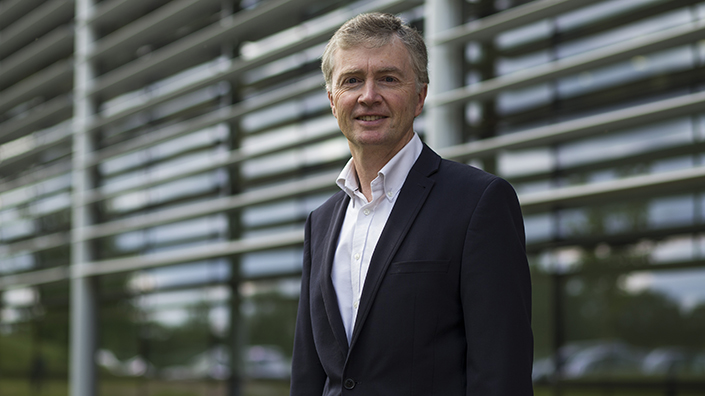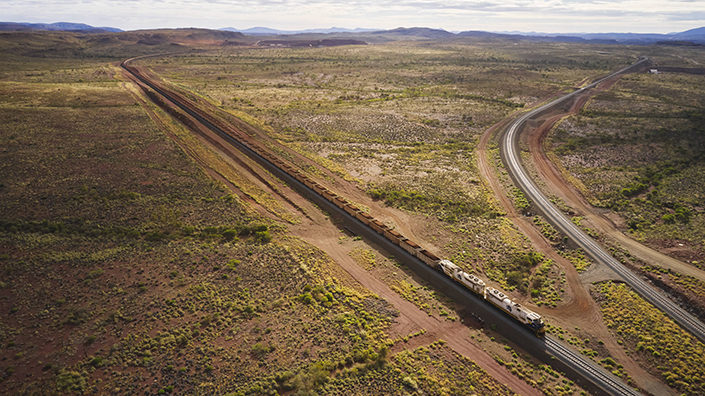Despite all that room, some things will simply not fit – as the team quickly found out at the start of an electrification project with Australian mining firm Fortescue Metals Group (FMG).
“They said to us, ‘We’ll send you a truck if you want’,” says lead integration engineer Dave Sullivan. “We saw the pictures of this truck, they’re 7.6m wide, 7.2m high and 14m long. It wouldn’t even go up the A34 to get here.”
The sheer scale of the trucks from German-Swiss multinational Liebherr continues to present unique challenges for the project, which aims to deliver a zero-emission mining fleet. Prototype testing is done on equipment designed for wind turbines at the Offshore Renewable Energy Catapult in Northumberland, for example. “It was one of the only dynamometers in the UK big enough to be able to actually absorb the power that we’re generating on these wheel motors,” says Sullivan.
Such are the considerations when tackling the mammoth task of electrifying some of the biggest vehicles on Earth, being used in one of the most punishing and energy-intensive industries.
While mining by its very nature will always have a drastic environmental impact, FMG is determined to minimise the contribution of the vehicles that it uses, and has set the ambitious target of completely decarbonising its mining operations by 2030.
“To achieve that, they’ve got a broad range of problems,” says Paul McNamara, technical director at WAE. “They’ve got to get hold of green electricity, for which they need both solar and windfarms to be installed. They need static storage to help manage that.”
The biggest challenge, however, may well be electrification of the hundreds of vehicles that excavate, shuttle and transport iron ore in the Australian Outback. Enter WAE, which is using its motorsport-honed battery expertise to super-size electrification.
Digging deep
Mining trucks are the biggest vehicles in the fleet, responsible for moving ore around the mines. WAE, which was acquired by FMG for £164m in March 2022 and is expanding from 400 staff to 1,000 over the next few years, is working with Liebherr and FMG’s Fortescue Future Industries enterprise to develop and supply electric battery and fuel-cell systems, which will be integrated into the T 264 trucks. After initial deliveries to FMG, the vehicles will be offered to other customers.
Fully laden, the trucks weigh 400 tonnes – 180-tonne truck, 220-tonne payload. Currently, they have diesel-electric powertrains, with diesel engines driving a generator, which drives motors on the back wheels. In the simplest terms, the project will remove the diesel engine and generator, and replace them with a battery.
Ancillary systems – including steering, cooling and hydraulic power for the tipper and brakes – complicate matters. Currently driven off the diesel engine, they require AC power, while the batteries are DC, meaning that a 600kW 1.5kV-0.7kV stepdown converter is required. Its silicon carbide technology delivers efficiency of 98.5%, while full-power operation takes place at ambient temperatures of 50ºC.
Visiting the WAE workshops, the giant scale of the battery packs is immediately clear. Each weighing 1.7 tonnes, they would take up most of the room in a car – each truck will have eight, the overall battery system offering 1.6MWh capacity.
The project is targeting the same performance capability as the diesel powertrain, and the ‘fuelling’ time is no exception. “The challenge with electrifying the mining industry is you’ve got big, heavy equipment needing megawatt-hours of storage. So it needs to be charged quickly, the equipment needs to be available 24/7, it’s a commercial running enterprise,” says McNamara.

Paul McNamara, technical director at WAE
The WAE battery management system (BMS) is a key component in the push for sub-30-minute charge times for the lithium-ion batteries. A battery management unit uses advanced state detection algorithms for efficient energy use and maximised charge rates, while cell management units use realtime telematics to maximise cell performance, including high-precision voltage and temperature monitoring. The BMS algorithms, trained on data from WAE’s own research, tailor the charge rate for the exact state of the battery.
Safety is another key concern. “It’s got to be very robust,” says Sullivan. “It’s got specific strength and stiffness requirements just to be in the truck, but also, with that kind of mining, there is a real chance of environmental damage such as heavy rocks being dropped on it.
“If you bear in mind what this truck does, it pulls up next to a massive excavator, the excavator picks up 50 tonnes of rock and drops it in the truck.
“What we don’t want to happen is for a rock to fall onto a battery or high-voltage component and cause a short circuit.”
With a robust alloy frame for durability, the Off-Highway Battery Module is designed for a long life in extreme conditions. Laser-welded cell-to-busbar technology is also aimed at in-service reliability, while the casings are made of aerospace-grade aluminium.
Internal sensors measure temperature, as well as gas emissions, pressure and humidity, and will activate a fire-suppression system that floods the module with liquid if an issue is spotted. Other back-up systems have been introduced to avert the threat of spark generation, a particularly pressing concern operating at 1,500-1,800V in the sensitive mine environment.
Energy regen
WAE is also introducing its regenerative braking technology – originally designed for Formula One cars – to recover as much energy as possible as the trucks move around. Mine layout and operation makes this a significant challenge, however.
“They come up out of the pit fully laden and they go back down empty, so there’s a limit to how much ‘regen’ you can do,” says Sullivan. That limit is exacerbated by the ‘dynamic braking’ that the trucks currently use, using the drive motors to brake – effectively burning off energy that could otherwise be used.
Regen during downhill sections between charges can nonetheless extend battery life by 30-40%. Remote management and autonomous operation of the vehicles also present extra opportunities for energy efficiency.
“When you start to go downhill you want an empty battery really,” says Sullivan. “If you know that route, and you know the geometry of it, you can say ‘I’m only going to charge that truck to 60%’. Because, as soon as it gets down the bottom, it’ll be 100%, and I’ve got all the energy captured. That goes into the programming of the autonomous system, and the routes and planning, so that you make the most of that energy capture.”
Infinity Train
Everything is bigger in the Australian Outback, from the spiders to the vast expanses of open desert. The trains are no exception – each Fortescue train is about 2.8km long, with multiple locomotives hauling up to 34,400 tonnes of ore in 244 cars. The company’s rail operations consumed 82m litres of diesel in the 2021 financial year.
Thankfully, WAE’s energy capture could improve the inefficient system. The mines are 400m above sea level – and the ports the ore is destined for – presenting a unique opportunity for large-scale regen.
“The idea with the Infinity Train is that it will run downhill fully laden,” says Sullivan. “We want to capture as much energy from that as we can on the way down, store it all in batteries, so, when that train turns around and comes back up empty, it’s all free – it just uses energy that it’s captured.”

Fortescue trains can be 2.8km long, with multiple locomotives hauling up to 34,400 tonnes of ore. WAE aims to replace diesel fuel with energy regeneration technology
FMG is so confident in the concept that it believes it will remove the need for installation of renewable energy and recharging infrastructure, while ‘eliminating’ diesel use and emissions from rail operations.
The two or three locomotives per train do not offer the traction needed for sufficient regen, however, so the partners are developing a tender car fit for the 21st century. These powered cars would be distributed throughout the train, capable of absorbing, storing, then transferring energy back to locomotives.
The team is also working with suppliers to optimise motors for regen capability. “A typical train motor is optimised for delivering torque, delivering power,” says Sullivan. “This has to be a slightly different perspective, it has to be optimised around generating electricity. You can afford to be a little less efficient on delivering the energy, the traction side, as long as you’ve got that recovery. The recovery side is the much more important aspect of it.”
Autonomous and remote operation will also eventually help maximise the energy efficiency. Drivers currently aim to arrive at port as quickly as possible, but the rate of descent will need to be optimised for the perfect charge rate.
Reuse and recycle
As FMG pursues net-zero emissions by 2030, the partners will explore opportunities to cut emissions elsewhere. A range-extended version of the electric mining truck, with an additional hydrogen fuel cell, will operate longer routes back and forth from mines’ central processing units. The giant tools that wrench the iron ore from the ground could even get the electrification treatment – dozers that push the dirt around, excavators that pick up and drop the ore into the trucks, and the drill rigs that pierce the earth.
“Some of those things are a bit more static than the mining trucks, so we have an off-board power unit that you can plug into,” says McNamara. “A mobile battery pack moves to the excavator, which doesn’t move much, and powers that.”
Those battery packs could be the very same ones used in the mining trucks, thanks to a common module that can form batteries of all sizes. Because of the extreme demands of commercial operation, batteries might be used in the trucks for as little as one or two years, before transitioning to static storage.
“We also envisage coming out of static storage at some time, remanufacturing, go back into the front of that chain with a lot of the components from the module intact, but obviously the core cells changing. It’s a broad infrastructure around the mine that we’re trying to create,” says McNamara.
Like the mining truck and the Infinity Train, an operational mine itself is a huge and lumbering system – one that has, until now, depended on copious use of polluting fossil fuels. The system could become more sustainable, thanks to some engineering finesse from WAE.
Want the best engineering stories delivered straight to your inbox? The Professional Engineering newsletter gives you vital updates on the most cutting-edge engineering and exciting new job opportunities. To sign up, click here.
Content published by Professional Engineering does not necessarily represent the views of the Institution of Mechanical Engineers.